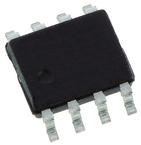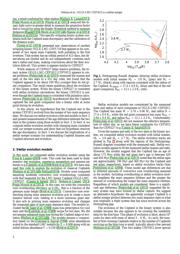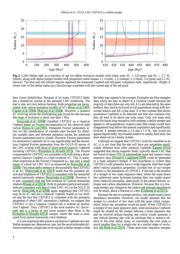Datasheet 搜索 > 运算放大器 > TI(德州仪器) > LMC6041IM/NOPB 数据手册 > LMC6041IM/NOPB 其他数据使用手册 1/5 页

 器件3D模型
器件3D模型¥ 18.228
LMC6041IM/NOPB 其他数据使用手册 - TI(德州仪器)
制造商:
TI(德州仪器)
分类:
运算放大器
封装:
SOIC-8
描述:
CMOS 运算放大器,LMC/LPC 系列### 运算放大器,Texas Instruments
Pictures:
3D模型
符号图
焊盘图
引脚图
产品图
LMC6041IM/NOPB数据手册
Page:
of 5 Go
若手册格式错乱,请下载阅览PDF原文件

arXiv:1508.02725v1 [astro-ph.SR] 11 Aug 2015
Astronomy & Astrophysics
manuscript no. 1812
c
ESO 2015
August 13, 2015
Letter to the Editor
The strange evolution of the Large Magellanic Cloud Cepheid
OGLE-LMC-CEP1812
Hilding R. Neilson
1
, Robert G. Izzard
2,3
, Norbert Langer
3
, and Richard Ignace
4
1
Department of Astronomy & Astrophysics, University of Toronto, 50 St. George Street, Toronto, ON, M5S 3H4, Canada
e-mail: neilson@astro.utoronto.ca
2
Institute of Astronomy, University of Cambridge, Madingley Road, Cambridge, CB3 0HA, United Kingdom
3
Argelander-Institut f¨ur Astronomie, Universit¨at Bonn, Auf dem H¨ugel 71, D-53121 Bonn, Germany
4
Department of Physics & Astronomy, East Tennessee State University, Box 70652, Johnson City, TN 37614 USA
ABSTRACT
Classical Cepheids are key probes of both stellar astrophysics and cosmology as standard candles and pulsating variable stars. It is
important to understand Cepheids in unprecedented detail in preparation for upcoming GAIA, JWST and extremely-large telescope
observations. Cepheid eclipsing binary stars are ideal tools for achieving this goal, however there are currently only three known
systems. One of those systems, OGLE-LMC-CEP1812, raises new questions about the evolution of classical Cepheids because of
an apparent age discrepancy between the Cepheid and its red giant companion. We show that the Cepheid component is actually the
product of a stellar merger of two main sequence stars that has since evolved across the Hertzsprung gap of the HR diagram. This
post-merger product appears younger than the companion, hence the apparent age discrepancy is resolved. We discuss this idea and
consequences for understanding Cepheid evolution.
Key words. binaries: eclipsing — stars: evolution — stars: late-type — stars: variables: Cepheids
1. Introduction
Classical Cepheids have been crucial for the understanding of
stellar astrophysics and cosmology since the discovery of the
Cepheid Leavitt law more than a century ago (Leavitt 1908).
They have been used to measure the Hubble constant (Hubble
1929; Riess et al. 2011; Freedman et al. 2012) to a precision of
2% as well as to constrain the detailed physics of stellar struc-
ture and evolution (e.g., Bono et al. 2000), yet there still exist a
number of mysteries regarding these stars.
One such challenge is the detailed calibration of the Cepheid
Leavittlaw, i.e., the period-luminosity(PL) relation. In the forth-
coming era of the James Webb Space Telescope, it is expected
that we will be able to measure the Hubble constant to less than
1% precision(Freedman & Madore 2010),butthis requiresmea-
surements of Cepheid fundamental parameters to unprecedented
accuracy along with independent measurements of Cepheid dis-
tances. The Gaia satellite is currently operating and will measure
distances to thousands of Galactic Cepheids (Windmark et al.
2011), that will complement Large Magellanic Cloud (LMC)
Cepheids for which distances are known.
One enduring uncertainty is the decades-old ‘Cepheid mass
discrepancy’ (Cox 1980), where Cepheid masses measured us-
ing stellar evolutionand pulsation calculations differ by about 10
– 20% (Keller 2008). Bono et al. (2006) suggested four possible
resolutions to this discrepancy: changes in the radiative opac-
ities, rotation, convective core overshooting in main sequence
progenitors and stellar mass loss. Neilson et al. (2011) showed
that pulsation-driven mass loss can partly explain the mass dis-
crepancy, while Anderson et al. (2014) proposed rotation as an
alternative solution. Convective core overshooting has also been
shown to resolve the mass discrepancy (Cassisi & Salaris 2011).
The solution to the mass discrepancy might simply be a combi-
nation of all three and understanding which physical processes
are important will constrain both evolution and pulsation mod-
els. However, an ideal method to constrain the Cepheid mass
discrepancy is to independently measure Cepheid masses.
Cepheid distances and masses can be measured in eclipsing
binary systems. Evans et al. (2005) suggested that about 35% of
all Galactic Cepheids are in spectroscopic binary systems, but
none are known to be in eclipsing binary systems. Evans et al.
(2013) presented a catalogue of binary companions detected
using ultraviolet spectral observations, where the companions
are all about 2 M
⊙
, inferring a larger binary fraction of 60%.
Evans et al. (2015) report radial velocity measurements which
further refine the measured binary fraction of Cepheids, noting
that what has been measured is a minimum possible binary frac-
tion. Neilson et al. (2015) show that a binary fraction of about
60% is consistent with the observed binary fraction of main se-
quence B-type stars from Kouwenhoven & de Grijs (2008).
Three eclipsing binary Cepheids have been discovered in the
LMC (Soszynski et al. 2008). These eclipsing binary systems
provide unique mass and distance estimates that can be com-
pared to estimates using Cepheid evolution and pulsation mod-
els. Thesehelp to resolvethe Cepheid mass discrepancyandcon-
strain the PL relation in greater detail.
Pietrzy´nski et al. (2010) presented detailed observations of
one such eclipsing binary, OGLE-LMC-CEP0227 (CEP0227),
with a 310 day orbit and a mass ratio between the components
of q = 1.00± 0.01. One binary component is a classical Cepheid
and the companion a red giant star. The authors measured a
Cepheid mass M = 4.14± 0.05 M
⊙
which is consistent with stel-
lar pulsation estimates. Cassisi & Salaris (2011) compared the
observed fundamental parameters with stellar evolution calcula-
tions and found that evolutionary models agree with measured
parameters if one assumes moderate convective core overshoot-
1
器件 Datasheet 文档搜索
AiEMA 数据库涵盖高达 72,405,303 个元件的数据手册,每天更新 5,000 多个 PDF 文件





